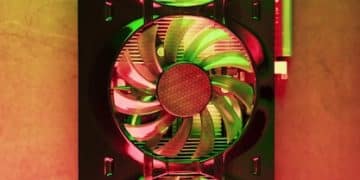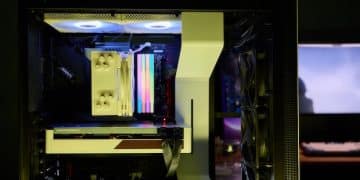Build a Budget Gaming PC: Powerful Rig Under $800 in the US
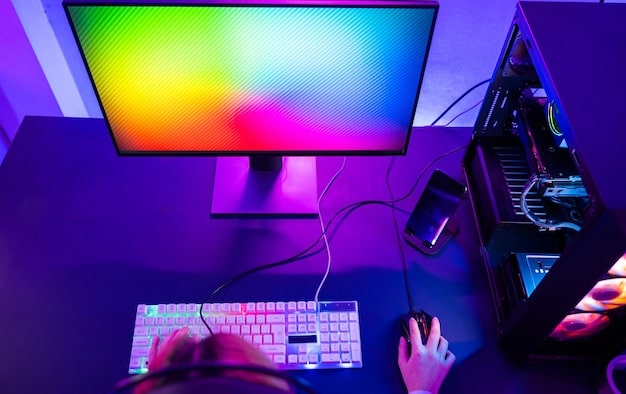
Building a powerful gaming PC on a budget in the US is achievable by carefully selecting components, optimizing for performance, and taking advantage of deals, all while staying under the $800 price point.
Dreaming of PC gaming without breaking the bank? Building a PC Gaming on a Budget: How to Build a Powerful Rig for Under $800 in the US is more than possible with smart planning and component selection. This guide will show you how.
Choosing the Right Components for Your Budget Gaming PC
Selecting the right components is crucial when building a budget gaming PC. It’s about balancing performance and cost, ensuring you get the most bang for your buck. Let’s explore each key component.
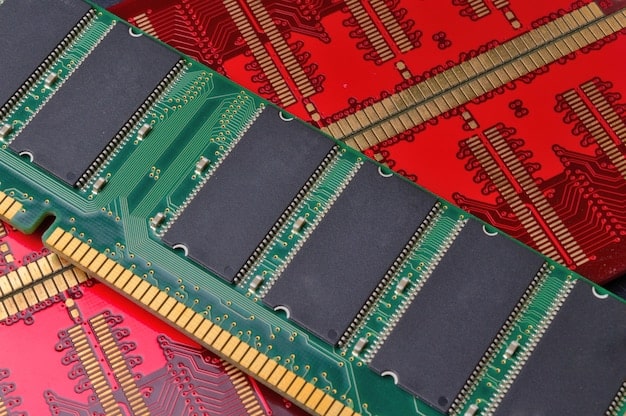
Processor (CPU)
The CPU is the brain of your PC. For budget builds, consider CPUs that offer a good balance of cores, threads, and clock speed without inflating the price. AMD Ryzen processors are often a great choice for budget builds.
Graphics Card (GPU)
The GPU is arguably the most important component for gaming. Look for a GPU that can handle your desired resolution and frame rates. Used or older generation GPUs can offer excellent value.
- AMD Radeon RX 6600: This card provides excellent 1080p gaming performance and often falls within the budget range.
- NVIDIA GeForce RTX 3050: Similar to the RX 6600, this card offers solid 1080p gaming and supports ray tracing.
- Used Market: Consider looking for used GPUs like the GTX 1070 or RX 580, which can still offer decent performance at a lower price.
Careful component selection in the GPU is vital to a balanced budget gaming PC build.
Selecting a Motherboard and RAM for Your Gaming PC
The motherboard and RAM are essential for system stability and performance. Choosing compatible and efficient components within your budget requires research and a bit of compromise.
Motherboard Considerations
The motherboard acts as the central hub connecting all your components. Ensure it’s compatible with your CPU and has enough slots for your RAM and other expansion cards. A basic ATX or Micro-ATX board will often suffice for budget builds.
RAM (Memory)
RAM is crucial for smooth multitasking and gaming. 16GB of RAM is the sweet spot for modern games. Look for DDR4 RAM with a speed of at least 3200MHz for optimal performance.
- Speed and Latency: Aim for RAM with a speed of 3200MHz or higher and a CAS latency (CL) of 16 or lower.
- Dual-Channel Configuration: Using two sticks of RAM in a dual-channel configuration can improve performance compared to a single stick.
- Brand Reliability: Stick with reputable brands like Corsair, Crucial, or G.Skill for reliable RAM.
Balancing cost and efficiency is crucial when selecting the motherboard and RAM for a budget gaming rig. Understanding their impact ensures optimal performance without overspending.
Storage Solutions: SSD vs. HDD for Budget Gaming
Choosing the right storage solution is vital for game loading times and overall system responsiveness. The debate between SSD and HDD comes down to speed versus capacity, and budget-conscious decisions must be made.
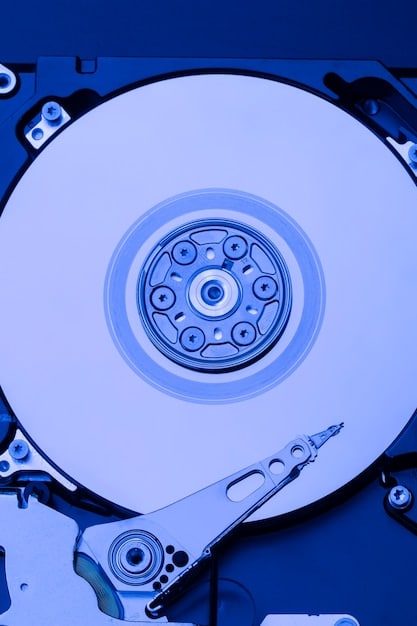
Solid State Drive (SSD)
An SSD provides significantly faster read and write speeds compared to a traditional HDD. This translates to quicker boot times, faster game loading, and a more responsive system. A 500GB or 1TB SSD is recommended for your primary drive.
Hard Disk Drive (HDD)
HDDs offer much larger storage capacities at a lower cost per gigabyte. While they are slower than SSDs, they can be a good option for storing large game libraries and media files. Consider adding a 2TB or larger HDD for additional storage.
It’s wise to invest in an SSD for the operating system and frequently played games, while using an HDD for mass storage of less frequently accessed files.
Power Supply and Case
The power supply unit (PSU) and case are often overlooked but crucial for the stability and longevity of your gaming PC. Let’s break down the considerations for each.
Power Supply Unit (PSU)
The PSU provides power to all your components. Ensure it has enough wattage to handle your system’s power requirements with some headroom for future upgrades. Look for a PSU with an 80+ Bronze certification for efficiency.
PC Case
The case houses all your components and provides cooling. Choose a case with good airflow and enough space for your components. Consider factors like size, aesthetics, and ease of cable management.
- Airflow: Good airflow is essential to keep your components cool. Look for a case with mesh front panels and support for multiple fans.
- Size: Choose a case size that fits your motherboard (ATX, Micro-ATX, or Mini-ITX) and has enough space for your components.
- Cable Management: A case with good cable management features will make your build cleaner and improve airflow.
A good PSU and PC case are essential for PC gaming performance and longevity.
Assembling Your Budget Gaming PC: A Step-by-Step Guide
Assembling your gaming PC can seem daunting, but with patience and a step-by-step approach, it’s manageable. Here’s a simplified guide to help you through the process.
Prepare Your Workspace
Before you start, make sure you have a clean and well-lit workspace. Gather all your tools, including a screwdriver, zip ties, and anti-static wrist strap.
Install CPU and RAM
Start by installing the CPU on the motherboard, followed by the RAM. Refer to your motherboard manual for the correct installation procedures.
This section will guide you through:
- Installing the Motherboard: Place the motherboard inside the case and secure it with screws.
- Installing the GPU: Insert the GPU into the PCIe slot and secure it.
- Connecting Storage Devices: Connect the SSD and HDD to the motherboard and PSU.
- Connecting the PSU: Place the PSU in its bay and connect the necessary cables to the motherboard and other components.
- Cable Management: Organize the cables to improve airflow and aesthetics.
- Testing the System: Before closing the case, test the system to ensure everything is working correctly.
Take your time and double-check each connection to ensure everything is properly installed.
Optimizing Your Gaming PC for Performance
Once your PC is assembled, optimizing it for performance is important. This involves installing drivers, tweaking settings, and monitoring temperatures.
Install Drivers
Install the latest drivers for your motherboard, GPU, and other components. These drivers can be found on the manufacturer’s website.
Update BIOS
Updating the BIOS can improve system stability and compatibility. Refer to your motherboard manual for instructions on how to update the BIOS.
Tweaking settings such as:
- Overclocking (Optional): Overclocking the CPU and GPU can improve performance, but proceed with caution and monitor temperatures closely.
- Software Optimization: Disable unnecessary startup programs and background processes to free up resources.
- Monitoring Temperatures: Use monitoring software to keep an eye on CPU and GPU temperatures.
Proper optimization ensures your budget gaming PC runs smoothly and efficiently.
| Key Point | Brief Description |
|---|---|
| 💡 CPU Selection | Choose a CPU with a good balance of cores, threads, and clock speed for gaming. |
| 🎮 GPU Choice | Select a GPU that can handle your desired resolution and frame rates without breaking the bank. |
| 💾 Storage Options | Opt for an SSD for fast boot times and load times, supplemented by an HDD for mass storage. |
| 💰 Budget Awareness | Keep an eye on sales, used markets, and component compatibility to stay within budget. |
Frequently Asked Questions
▼
The graphics card (GPU) is often considered the most crucial component for gaming, as it handles the visual output and rendering of games. A powerful GPU can significantly improve the gaming experience.
▼
Building your own PC often provides better value for money and allows you to customize components to your specific needs. However, pre-built PCs are more convenient for those who don’t want to assemble one themselves.
▼
16GB of RAM is generally recommended for modern gaming. It provides enough memory for most games and allows for smoother multitasking. You can technically game with 8GB, but 16GB is preferred.
▼
Yes, one of the advantages of building your own PC is the ability to upgrade components later. This allows you to improve performance over time without having to replace the entire system. Ensure your components are compatible.
▼
An SSD (Solid State Drive) is much faster than an HDD (Hard Disk Drive). SSDs offer quicker boot times, faster game loading, and overall better system responsiveness. HDDs are cheaper and offer larger storage capacities.
Conclusion
Building a PC Gaming on a Budget: How to Build a Powerful Rig for Under $800 in the US requires careful planning and smart component selection. By prioritizing key components, taking advantage of deals, and optimizing your system, you can achieve a great gaming experience without overspending.


